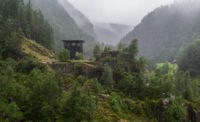Raw beauty and haunting poetry emerge from the idiosyncratic collaboration between Swiss architect Peter Zumthor and the late French-born artist Louise Bourgeois in Vardø, Norway. Here in the country's northeasternmost town (population: 2,000) above the arctic circle, you now find an arresting shrine to 91 people in the area who were tried and burned at the stake in the 17th century for the crime of witchcraft. Centuries later, the Steilneset Memorial for the Victims of the Witch Trials in Vardø officially opened June 23, presided by Her Majesty Queen Sonja of Norway.
The unusual project, sponsored by the town of Vardø, Finnmark County, the Varanger Museum, and the Norwegian Public Roads Administration, offers another stop on the much- heralded National Tourist Routes in Norway [Record, October 2007, page 90]. Because the memorial brings belated attention to aberrations of justice that occurred long ago, it may seem just a touristic ploy to attract sightseers to the craggy Steilneset promontory off the barren Varanger peninsula, where reindeer gambol and sheep never seem to sleep ' at least on sunny summer nights. However, as Sturla J. Stalsett, general secretary of the Vardø Church City Mission, pointed out during the opening ceremonies, the memorial is meant to remind us of the ongoing danger of collectively creating scapegoats. If historical circumstances seem peculiar now, the intent behind the work addresses larger moral claims.
While Norwegian architects competed for commissions to design the rest areas and look-out points on the scenic routes, the Steilneset memorial, initiated in 2000, was different. Artist Knut Wold, a consultant and curator for the National Tourist Routes, along with colleague Svein R'nning, suggested Bourgeois be commissioned for a different point of view. Since an architect would be needed to enclose her piece, Wold thought of Zumthor, whom he knew from the design of the Zinc Mine Museum in Sauda, Norway, begun in 2002 and now under construction. Wold discovered that Zumthor and Bourgeois already were working together on an art/architecture project for Dia:Beacon museum in Hudson, New York (2003), that ultimately was not realized. The new collaboration seemed a natural.
Since Bourgeois, who died in 2010, was 94 at the start of the memorial design in 2006, she enlisted her longtime assistant, Jerry Gorovoy, to help execute her ideas and asked Zumthor to go to the site first for his impressions. As Zumthor puts it,'She was to make the art installation, and I would make the shell.' Arriving in Vardø, the architect was struck by the harsh, treeless landscape along the Barents Sea, and the indigenous man-made elements such as spindly diagonal wood racks for drying fish, once a major export item. He also found the lamps in the small curtainless windows of the houses had a certain poignancy.
To memorialize the 77 women and 14 men who were victims of the witch hunt, Zumthor envisioned a long building with a taut wood-frame structure and a sailclothlike walls, to be perched atop the rocky, granite coast. Inside the elevated structure, he designed small windows randomly punched on both sides to commemorate those executed. In the center of each window would be suspended a single lightbulb. 'I didn't want an aggressive, massive monument. Creating a light, delicate structure was best for this rough place,' he says.
When Zumthor showed his sketches to Bourgeois, she said she liked them but felt his work was complete. She needed her own space, and so it was agreed that Zumthor would design a separate building for Bourgeois's piece, which features a burning chair.
Visitors enter the memorial on the north by a gangplank placed perpendicularly to the elevated Zumthor structure, a 410-foot-long building within which a tensile structure of polytetrafluoroethylene (PTFE)-coated fiberglass fabric is suspended on cables. Once inside, the visitors proceed along a 328-foot wood-plank catwalk about 5 feet wide. As they thread their way through the dark cocoon of the interior, visitors pass 91 windows, each dimly lit by an exposed-filament bulb. Ropelike cords from the lamps form scalloped borders at the edges of the undulating ceiling. The feeling is like being in the stomach of some prehistoric creature, half-fish, half-reptile ' except there is a glimmer of light.
At the south end, visitors exit on a gangplank that leads down to the entrance of the glass cubiform volume housing Bourgeois's piece. The pavilion's 39-by-39-foot square roof of Cor-Ten steel is supported by Cor-Ten steel columns at the room's perimeter. Horizontal steel brackets in turn brace the 17 large panes of dark glass, which Zumthor likens to welding goggles.
Owing to the high winds on the site, the glass walls stop short of the ceiling and floor and slide past each other to allow gaps for wind drafts. In the middle of the space is Bourgeois's piece, an aluminum chair with gas flames shooting out of the seat. In this rather literal evocation, the burning chair is reflected in seven oval mirrors placed on metal columns in a ring around the fiery seat, like judges circling the condemned. If you think you'll be too warm standing near the burning chair, don't worry. In this blustery place, temperatures rarely rise above 51 degrees Fahrenheit.
The extremely harsh climate naturally raises the question about the life of the long house's fiberglass fabric. Zumthor maintains that it is supposed to last 77.2 years. Let's hope. Because of the soil and wind, wood is hardly plentiful, and so the framing members were fabricated off-site. The membrane, made in Germany, with panels stitched in the factory, had to be installed in place using heat bags. In spite of the vernacular build-it-yourself look of the long house, its fabrication, like the glass pavilion, depended on contemporary techniques.
In the last analysis, you might well wonder if you need two separate structures, at a cost of about $15 million, to commemorate events that took place so long ago. Zumthor's long house would seem to do the job very effectively. But then again, you do get two distinct, provocative experiences for making the pilgrimage to Vardø.








